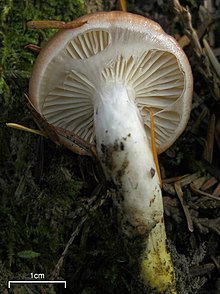pms
nòm ant ël fil


Original circumscription from Kauffman “The Genus Gomphidius in the United States” Mycologia 17(3): 120 (1925) http://www.jstor.org/...
“Pileus 3-6 (7) cm. broad, convex-expanded then plane, very obtuse to broadly depressed, with a viscid “separable pellicle, glutinous only in rainy weather, varying salmon-color” to “vinaceous-pink” (Ridg.), disk “ochre-red” to “testaceous,” usually fading, becoming slightly blackish on drying, glabrous, even or slightly wrinkled when dry; flesh thick on disk, abruptly thin on margin, white or tinged vinaceous. Gills decurrent, close to subdistant, attenuate at ends, 6-7 (8) mm. broad at middle, soon “pale smoke-gray” to “pale mouse-gray,” finally darker and variegated, some forked near margin or towards stem, thickish, edge entire. Stem 3-6 cm. long, 6-12 (15) mm. thick, tapering downwards or subequal, straight or curved, solid, base or lower half “lemon-yellow”, “empire-yellow” or “citron- yellow” (Ridg.), apex or upper portion white and silky, covered when fresh up to near the apex by the hyaline, viscid, thin, appressed sheath of the universal veil, at length glabrous and dry, rarely becoming sordid or blackish in age. Spores 14-17 (20) x 5- 6 µ, subfusiform-ellipsoid, obtuse at ends, smooth, dark sooty. Cystidia rather abundant, cylindrical above the slender pedicel, hyaline (in fresh plants), 100-140 × 8-15 µ, apex rounded. Odor and taste none.
Type on humus and moss under conifers, near Welch’s Post Office, Oregon National Forest, Mt. Hood, Oregon. September 22, 1922. Frequent in this region. Also under pines, Tolland, Colorado, September 14, 1920; and near Copeland, Idaho, September 2, 1922. Collected by C. H. Kauffman. Deposited in the herbarium of the University of Michigan.
This species differs from G. roseus (Fr.) Quel. by the distinct yellow base of the stem, by the less rosy-red color of the pileus attributed to the European plant, and perhaps by the cystidia. We apparently have no account of the cystidia of G. roseus. Ricken, to be sure, gives cystidia for the plant he places under that name, but Ricken’s description departs from the conception of other mycologists, and his plant may be the species here described, or perhaps it is G. gracilis. Rea (12) unaccountably copies Ricken’s remarks on the cystidia, but Rea’s description otherwise applies to the plant with a rosy stem-base, and is therefore to be considered the correct traditional conception of G. roseus.
G. gracilis Berk., although it has a yellow stem-base, is described by Berkeley as having a conic-hemispherical pileus and others agree that it is more or less umbonate; G. subroseus has a rounded pileus from the beginning and later becomes plane to depressed. After the specimens were dried they turned somewhat blackish, but when fresh this tendency to blacken – so noticeable a characteristic in some species – is very slight in this western species. From G. flavipes it is readily distinguished by its smaller spores, and from G. maculatus by the veil on the stem."
Edible.
Gomphidius subroseus is a gilled mushroom found in Europe[3] and North America. It was first described by Calvin Henry Kauffman in 1925.[4] It was once thought to be mycorrhizal with Pinus sylvestris.[3] However, Olson et al. (2002) found it to be more likely to be parasitic on Suillus bovinus, which is mycorrhizal with Pinus sylvestris, Pinus sylvestris or both.[3] It is considered edible but of low quality.[5] As with other species of the genus, removing the glutinous cuticle improves the taste.[6]
 The underside of the cap, showing the gills
The underside of the cap, showing the gills Gomphidius subroseus is a gilled mushroom found in Europe and North America. It was first described by Calvin Henry Kauffman in 1925. It was once thought to be mycorrhizal with Pinus sylvestris. However, Olson et al. (2002) found it to be more likely to be parasitic on Suillus bovinus, which is mycorrhizal with Pinus sylvestris, Pinus sylvestris or both. It is considered edible but of low quality. As with other species of the genus, removing the glutinous cuticle improves the taste.
Gomphidius subroseus
Gomphidius subroseus, de son nom vernaculaire, le gomphide rosâtre est un champignon basidiomycète de la famille des gomphidiacées originaire d'Amérique du Nord.
Le gomphide rosâtre pousse de juillet à octobre sous les conifères, souvent l'épicéa.
Gomphidius subroseus
Gomphidius subroseus, de son nom vernaculaire, le gomphide rosâtre est un champignon basidiomycète de la famille des gomphidiacées originaire d'Amérique du Nord.